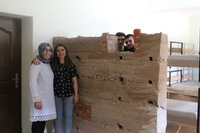THE 2017 PROGRAMME
ACTIVITIES
The 2017 Activities
In 2017, activities at the Kerkenes Eco-Center took place during the spring and summer
months when groups of students came to Kerkenes for a Hands on Building program led by
Matthieu Pedergnana. Facilities include the village school now rehabilitated and called the
Kerkenes Training Center. In April the Eco-Center hosted METU students participating in
Hands-on sessions for the Architecture in situ course, Arch 326. These students were hosted
for a 3 day program that included visits to the nearby archaeological site, the Iron Age
ancient city on the Kerkenes Dag. In July students from the Konya Karatay University took
part in a workshop at the end of which they were given a certificate. Accommodation and
meals were provided in the newly rehabilitated school with the assistance of the local
women from the village.
Ongoing research and educational activities on environmental design to maximize
energy efficiency, appropriate building materials and techniques were funded by a METU
BAP grant and generous donations from corporate sponsors.
Before their trip to Kerkenes, METU students enrolled in the Arch 326 course were
given an introduction on the Eco-Center's past activities, its status, mission and also the
ongoing archaeological research in the ancient city on the Kerkenes Dagi which they visited
(Figs 4 and 5). As part of the Hands-on program, they spent time working with local building
materials and experimenting with design alternatives. Matthieu Pedergnana gave a
presentation about earth and mud architecture to conclude the course.
During Hands-on sessions at the Kerkenes Eco-Center, METU students took part in
building and research activities focusing on environmental design and energy efficiency.
They visited all the experimental buildings that have been monitored to compare their
environmental behavior (Figs 6 and 7). They experimented mainly with earth architecture
considered to be an appropriate building material due to its low embodied energy, low CO2
emission and availability. To students were taught how to prepare the mixtures and worked
in groups on the design and building of small features (Fig. 8). In the dormitories they built
rammed earth partition walls with niches to be used as shelves (Figs 9 and 10). Standing slipstraw
partition walls were plastered with mud (Fig. 11). The students have also learnt to
produce traditional mudbricks and pressed bricks to be used in the Eco-Center (Figs 12, 13
and 14).
The students from Konya stayed in the Eco-Center and worked on small design
projects to improve the amenities. In one of the dormitories, they raised the rammed earth
wall and added another niche (Fig. 15). In the other dormitory, students used the mudbricks
that were produced in previous hands-on sessions to build another partition wall and
decorated it with glass bottles (Figs 16). They built some additional partition walls made of
slip-straw in the dormitory (Fig. 17). Another group of students designed and built a bench
made of cob (Figs 18 and 19). Finally students prepared posters for the jury (Fig. 20). At the
end of the workshop all students receive a certificate.
Activities of the Kerkenes Project Team
The Kerkenes Project Team from METU made several visits to the Kerkenes Eco-Center
and helped with necessary repair and maintenance. In the Kerkenes Training Center villagers
use the solar space to dry fruit and vegetables (Fig. 21). Solar cookers have been used to
make wild plum jam, a village specialty (Fig. 22).
The 2017 Bozok Symposium
In May 2017, a paper on the Kerkenes Eco-Center and its Eco-Tourism Potential was
presented at the Bozok Symposium (Figs 25 and 26). It presented an overview of the
achievements of the project and its potential as an eco-tourism destination (Fig. 27). The
paper submitted for publication is included in this report as an appendix.



